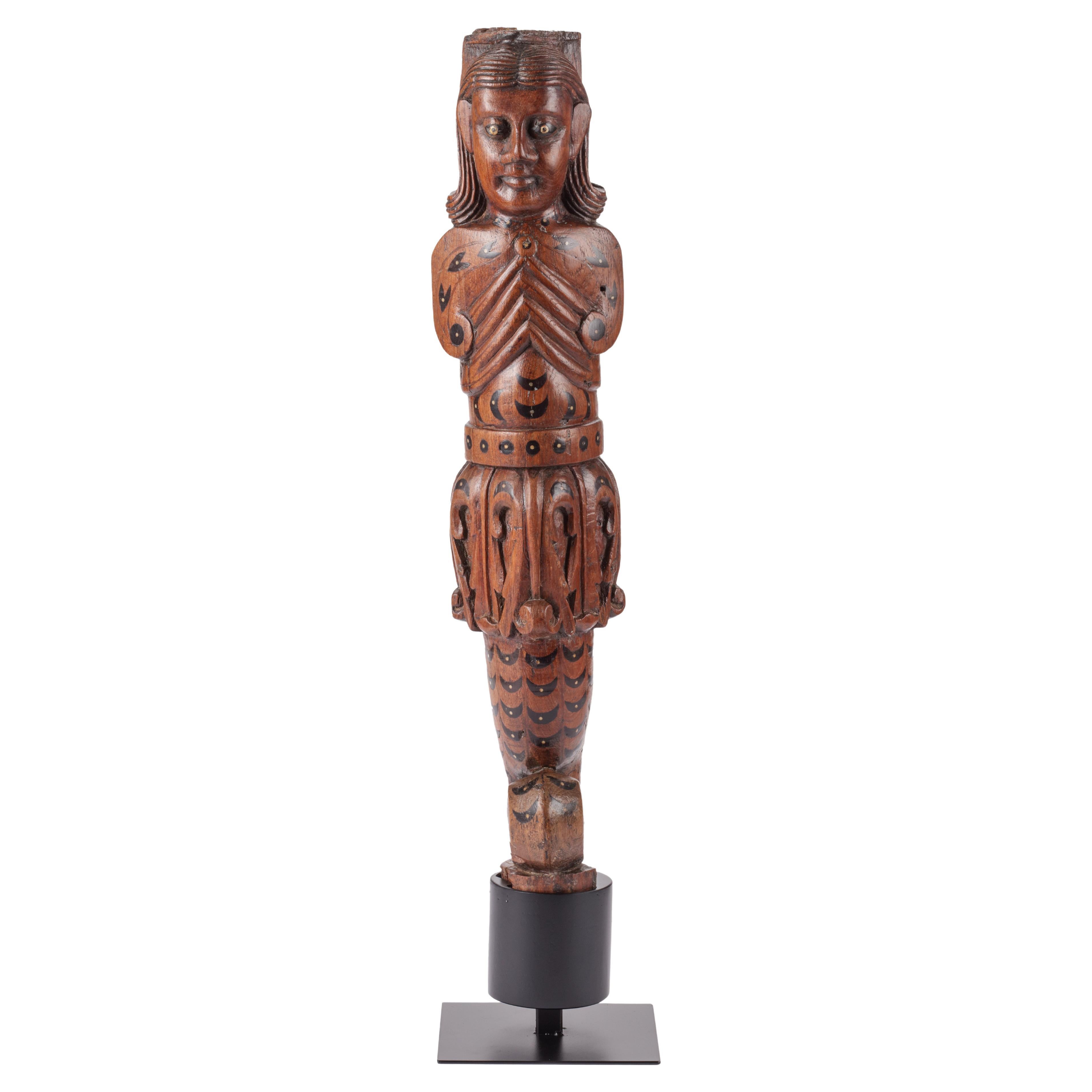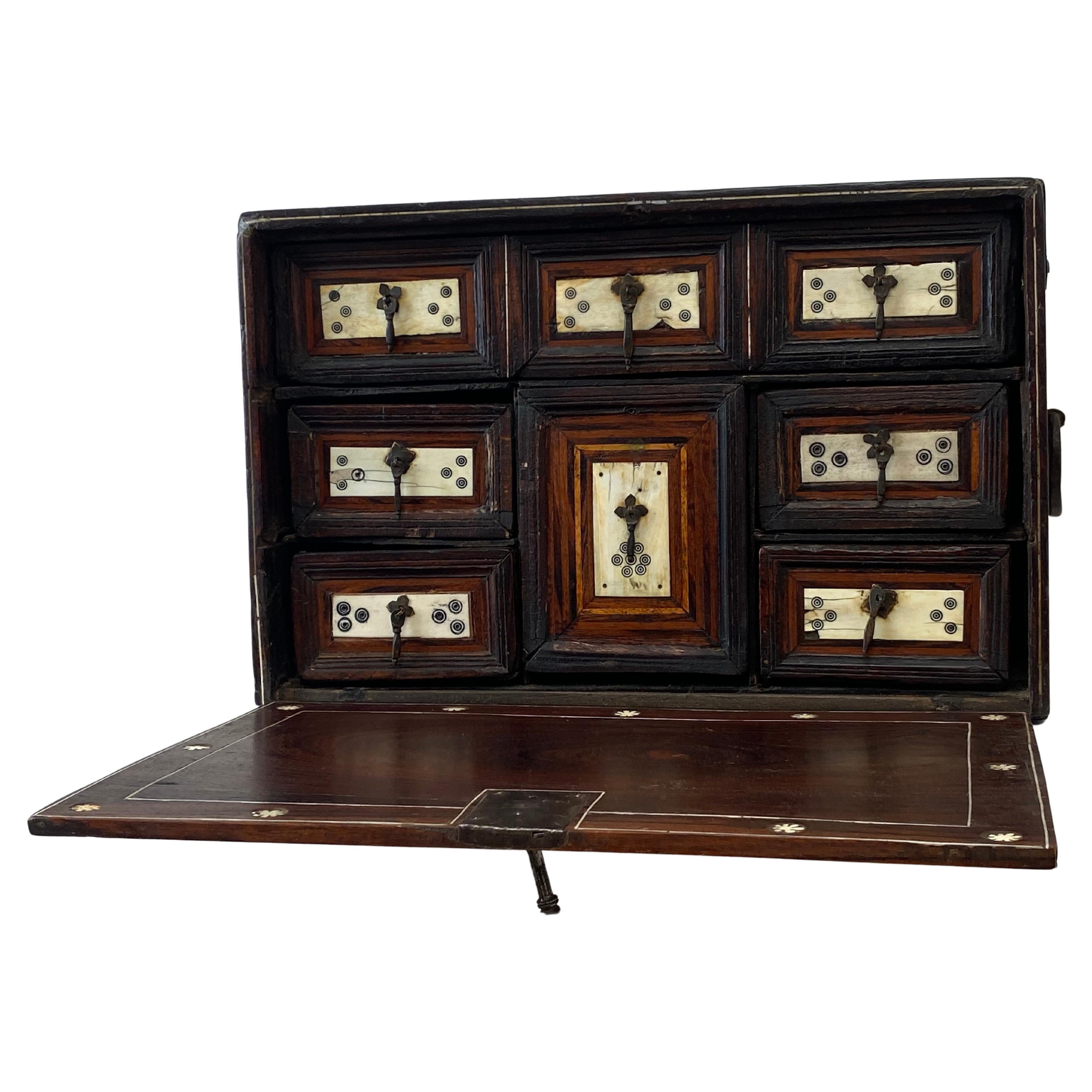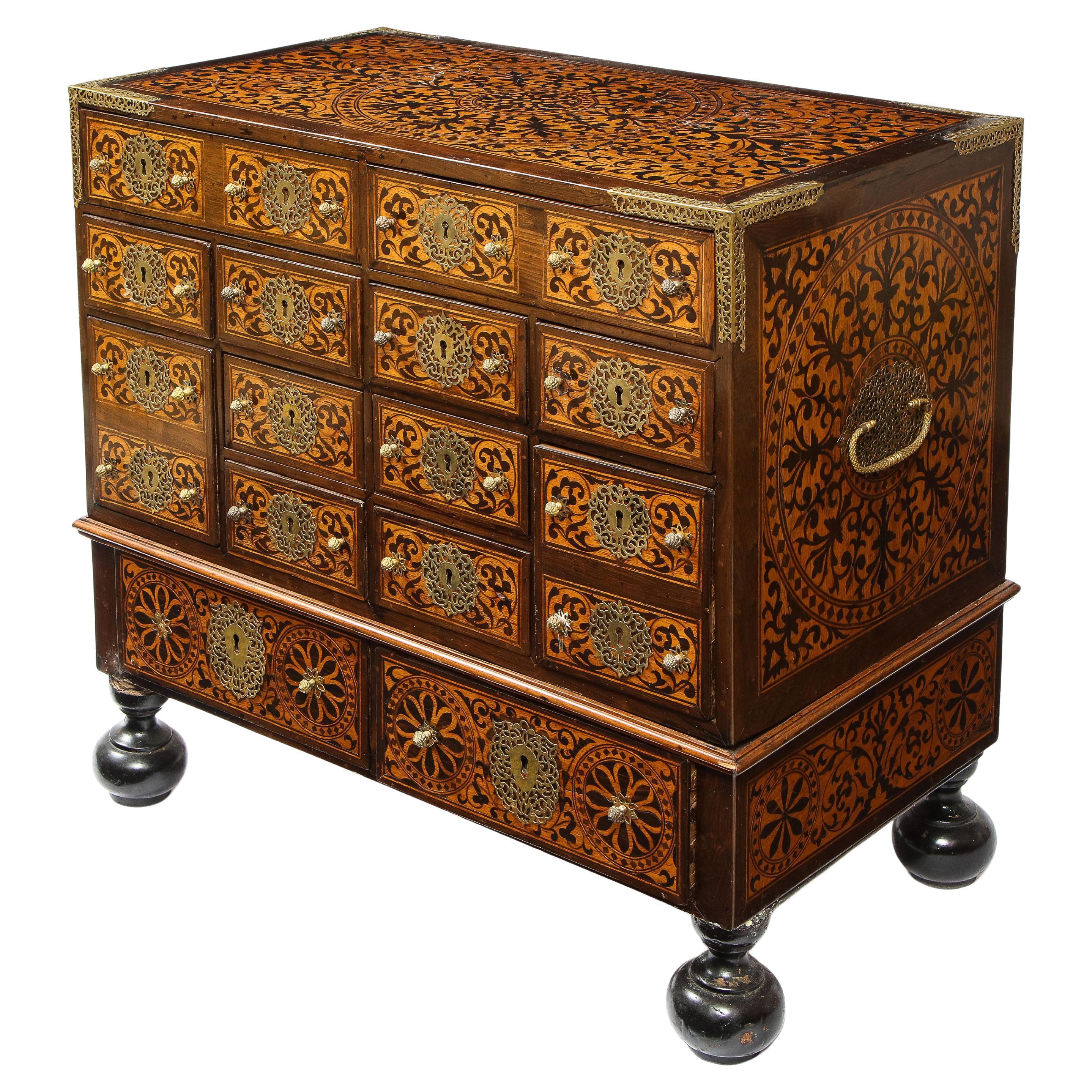Items Similar to 18 C, Indo-Portuguese Vargueno Mini Cabinet
Want more images or videos?
Request additional images or videos from the seller
1 of 20
18 C, Indo-Portuguese Vargueno Mini Cabinet
About the Item
Presenting a fabulously rare 18c Indo-Portuguese Vargueno mini cabinet.
Extremely rare, highly important and desirable colonial piece !
It is an Indo-Portuguese Vargueno mini cabinet, circa 1780, with strong Persian influences.
Vargueno’s are typically Portuguese or Spanish.
Portugal, through its colonization of parts of Asia in the 17th and 18th centuries, had a strong influence on furniture being made in India in the 17th and 18th centuries.
The Portuguese colonization of the sub-continent was mainly in South India, whilst the Persian influences would have been in the North.
Many examples of Indo-Portuguese Vargueno’s can be found. Typically, they are constructed using ivory and stained woods to depict neo-classical type scenes. These boxes command a hefty price tag !!
What makes this one even more special is that it is clearly a Vargueno box from that time period but it constructed entirely using a more Persian influenced mosaic of bone, brass, micro-mosaic green precious stone, pewter etc. in star or geometric shapes.
The top opens to reveal a number of storage sections.
The front opens to reveal more exquisite mosaic work and a number of spice drawers, hence, being called a Vargueno!
A truly unique piece !! A truly important piece !!
This should really be in a museum !.
- Dimensions:Height: 11.25 in (28.58 cm)Width: 14 in (35.56 cm)Depth: 9.75 in (24.77 cm)
- Style:Anglo-Indian (Of the Period)
- Materials and Techniques:
- Place of Origin:
- Period:
- Date of Manufacture:1780
- Condition:Repaired: Good condition for it’s age and construction. Some losses of inlay/mosaic with minor repairs. Has key but lock doesn’t work. Wear consistent with age and use. Minor losses. Minor structural damages. Minor fading. Good condition for it’s age and construction. Some losses of inlay/mosaic with minor repairs. Has key but lock doesn’t work.
- Seller Location:Dallas, TX
- Reference Number:1stDibs: LU3978132439132
About the Seller
4.9
Platinum Seller
These expertly vetted sellers are 1stDibs' most experienced sellers and are rated highest by our customers.
Established in 2015
1stDibs seller since 2018
349 sales on 1stDibs
Typical response time: <1 hour
- ShippingRetrieving quote...Ships From: Dallas, TX
- Return PolicyA return for this item may be initiated within 7 days of delivery.
More From This SellerView All
- 18C Indo-Persian Campaign Vanity BoxLocated in Dallas, TXPRESENTING AN EXTREMELY RARE AND HIGHLY IMPORTANT Indo-Persian Campaign Vanity Box from circa 1780-1800. Box inlaid with exquisite mosaic inlay. In the Indo-Persian style of mosaic with Islamic styles. The mosaic consists of green semi precious stone, bone, brass and pewter in star shaped geometric designs. Box opens up to reveal a travel mirror...Category
Antique 18th Century Indian Anglo-Indian Decorative Boxes
MaterialsMulti-gemstone, Brass
- Large Oriental Champleve Cloisonne Urn on StandLocated in Dallas, TXPresenting a beautiful and very high quality large oriental champlevé cloisonné urn on stand. Late 19th or early 20th century, circa 1890-1910. Pro...Category
Early 20th Century Japanese Japonisme Metalwork
MaterialsBrass, Bronze, Enamel
- 19C Anglo Ceylonese Specimen Wood Trinket BoxLocated in Dallas, TXPRESENTING A BEAUTIFUL and RARE 19C Anglo Ceylonese Specimen Wood Trinket Box. Made in ‘Galle’, Ceylon (now Sri Lanka) circa 1860-80. Made for the ex...Category
Antique 19th Century Sri Lankan Anglo-Indian Jewelry Boxes
MaterialsBone, Hardwood, Ebony, Sandalwood
- 19C Anglo Ceylonese Sewing Box of Museum QualityLocated in Dallas, TXPresenting an absolutely stunning 19c Anglo Ceylonese sewing box of museum quality. Made in Ceylon (now Sri Lanka) circa 1860, this is one of the finest sewing boxes of it’s kind that we have ever seen! The box is made from coromandel wood (an exotic hardwood found in Ceylon) and has a serpentine edging all over the front, back and sides. Very often the lids/tops of these boxes suffer cracks due to shrinkage but this one is near perfect with no crack in the lid/top. There is some evidence of natural shrinkage but that is around the edges of the lid/top. It is when you open this box that it reveals it’s true beauty, quality and treasure ! The inside of the lid/top is heavily and beautifully decorated with inlaid bone in scrolling floral patterns which have then been hand painted with red and black ‘lac’ ink. The central medallion is a circle of inlaid specimen exotic hardwoods radiating towards a central bone and hand painted flower. The circle is edged in bone, wood and silver chevrons. What makes this box Exceptionally rare is that it contains 3 lift out base sections. Normally, there would be a maximum of 2. The first tray/section is clearly for the purposes ancillary to sewing with a pair of sections with bone spools for thread etc. There are 17 other lidded compartments with each one highly decorated using hand painted bone and specimen woods to replicate tortoiseshell. The first tray lifts out to reveal a second removeable tray which is made up of a pair of open sections and 8 specimen wood lidded sections each with chevron banding. The third tray is a smaller tray underneath with 14 lidded compartments each with hand painted bone and specimen wood inlaid lids again, replicating the look of tortoiseshell. Again they are banded with a chevron border. This is a museum quality piece ! It is in fantastic condition for it’s age with the minor shrinkage to the edges of the lid/top, some finger pulls missing and some very minor cracks to the tray lids and bases but nothing that in any way detracts from the piece. No key. Dimensions: Closed the box is 16.75 inches wide, 11.25 inches deep and 7.5 inches high Fully open the box is 16.5 inches high, 16.75 inches wide and 11.4 inches deep Anglo-Indian and ceylonese boxes: Anglo Indian boxes were made in India for the English residents from the early part of the 18th century. They were brought back or sent back to England usually by the people who had commissioned them. From the beginning of the nineteenth century they were imported more commercially, although not in any significant numbers until the middle decades. They were very highly valued, especially the early ones, to the extent that the designs were copied on late 19th and early 20th century tins. Anglo-Indian boxes normally consist of 3 main types:- (1) Most of the best and highest quality Anglo-Indian boxes in the 18th and 19th centuries were made in Vizagapatam, India, renowned for its exquisite craftsmanship in using ivory and tortoiseshell and lac decoration. These are referred to as ‘Vizagapatam Boxes...Category
Antique Mid-19th Century Sri Lankan Anglo-Indian Decorative Boxes
MaterialsSilver
- 19C Anglo Indian Highly Carved Padouk and Mosaic Folio CoverLocated in Dallas, TXPRESENTING A RARE AND DESIRABLE 19C Anglo Indian Highly Carved Padouk and Mosaic Folio Cover. This is a VERY RARE piece of Anglo-Indian and British Victorian Colonial history! ...Category
Antique Late 19th Century Indian Anglo Raj Decorative Boxes
MaterialsBone, Precious Stone, Sandalwood
- 19C Anglo Indian Highly Carved Padouk and Sandalwood Sadeli Mosaic Sarcophagus SLocated in Dallas, TXPRESENTING A GORGEOUS 19C Anglo Indian Highly Carved Padouk and Sandalwood Sadeli Mosaic Sarcophagus Sewing Box. Made in Bombay, India circa 1860-80. Box made of sandalwood with highly carved padouk wood reliefs and panels on all sides. Edged with bone and ebony veneers and glorious sadeli mosiac, made from tiny pieces of faux ivory, pewter, green semi-precious stone. The box is in a sarcophagus form with domed lid. The original brass carry handles are on the sides. The interior is in great condition and consists of a removeable mirror under the lid portion, with the original red velvet lining behind it. The base is removeable and contains a number of lidded compartments. 6 of the interior lids on the base, are each inlaid with sadeli mosaic banding. The rest are also carved and chased. The interior is fully complete with 7 lidded faux ivory/bone, thread canisters with sadeli domes and the original bone thimble. The box sits on 4 brass ball or bun feet with the original velvet lining on the base. Some minor repairs and losses, but this box is fully complete. This is ‘rare’ as many of these boxes have not survived in such condition! Included in the sale are 2 photos that were in the box (under the base tray). Interestingly, one of them is a view of downtown Nassau, New Providence (Bermuda) from the early 20C and stamped on the rear. What a ‘journey’ this piece has made! Made in India … travelled to Bermuda, probably via Britain … back to Ireland (where we bought it) …. then to Texas! These boxes were made by superb Indian craftsmen, specifically for sale to the ruling British elite. These types of boxes, carved padouk and sandalwood, (whilst beautiful and superbly crafted) were of a lesser quality, than the more profusely and intricately mosaic inlay, tortoiseshell and ivory boxes, made for the British ‘Upper Classes’ in the areas of Bombay and Vizagapatam. These type of boxes were much more affordable back in 1880 (and indeed today) and would probably have been bought by mid-level diplomats, civil servants or visitors. Sewing boxes (in general), were in EVERY Victorian home in Britain in the 19th Century and like other boxes etc were ‘status symbols’ of your place in society! The more ornate the box, the more ‘Upper Class’ you were! Of it’s type, this one, is one of the very higher quality one’s, than the norm! SADELI MOSAIC: “Anglo Indian boxes were made in India for the English residents from the early part of the 18th century. They were brought back or sent back to England usually by the people who had commissioned them. From the beginning of the nineteenth century they were imported more commercially, although not in any significant numbers until the middle decades. They were very highly valued, especially the early ones, to the extent that the designs were copied on late 19th and early 20th century tins. The ancient art of Sadeli Mosaic is said to have been introduced from Shiraz in Persia via Sind to Bombay, a long time before the Anglo Indian boxes were made. It was a technique, which required a high degree of skill and patience. It was executed very lavishly, in that the frequent cuts wasted a great amount of the precious materials used. The workmanship was however more than commensurable to the value of the materials. Ivory, silver, pewter (or other metals), wood and horn were cut into faceted rods which were bound together to form geometric patterns. When the glue has set, the rods were sliced in transverse sections. This gave the maker a number of angled circular pieces in the original pattern. Several variations of patterns could be achieved by combining the materials in different ways. The ivory was sometimes dyed green to give an extra color. The mosaic pieces in a combination of patterns, often separated by ivory, ebony, horn or silver stringing were used to veneer sandalwood boxes. In the early boxes, which date from the turn of the 18th to the 19th century, there are large panels of mosaic covering tops and sides of boxes. It took incredible skill to cover such large areas without any shakes or wavering of the pattern. The corners and joins on these boxes are impeccably matched. The makers (reputed to be Persian) of Sadeli mosaic made in the first two decades of the 19th century displayed a total understanding of the qualities of the different materials they used. They combined substances, which can expand and contract according to atmospheric conditions with others, which are hard and unyielding. The result was a sharp definition of the lines and patterns, which made up the whole design. On the early boxes the designs look deceptively simple. The fact is, they emerged from a culture, which had mastered geometry and understood how to generate a pattern from a set number of points. The patterns are so harmoniously combined that their incredible complexity is not immediately apparent. The earliest Sadeli boxes...Category
Antique 19th Century Indian Anglo-Indian Decorative Boxes
MaterialsBone, Padouk, Sandalwood
You May Also Like
- 16th-Century Indo-Portuguese Colonial Mother-of-pearl Gujarat CasketLocated in Amsterdam, NLAn exceptional Indo-Portuguese colonial mother-of-pearl veneered casket with silver mounts India, Gujarat, 2nd half of the 16th century, the silver mounts Goa or probably Lisbon Measures: H. 16 x W. 24.6 x D. 16.1 cm An exceptional Gujarati casket with a rectangular box and truncated pyramidal lid (with slopes on each side and a flat top) made from exotic wood, probably teak (Tectona grandis), covered with a mother-of-pearl mosaic. The tesserae, cut from the shell of the green turban sea snail (Turbo marmoratus, a marine gastropod) in the shape of fish scales, are pinned to the wooden structure with silver ball-headed nails. The casket is set on bracket feet on the corners. The masterfully engraved decoration of the silver mounts follows the most refined and erudite Mannerist repertoire of rinceaux and ferroneries dating from the mid-16th century. The high quality and refinement of the silver mounts and, likewise, the silver nails that replaced the original brass pins used to hold the mother-of-pearl tesserae in place indicate the work of a silversmith probably working in Lisbon in the second half of the 16th century. The Indian origin of this production, namely from Cambay (Khambhat) and Surat in the present state of Gujarat in north India, is, as for the last three decades, consensual and fully demonstrated, not only by documentary and literary evidence - such as descriptions, travelogues and contemporary archival documentation - but also by the survival in situ of 16th-century wooden structures covered in mother-of-pearl tesserae. A fine example is a canopy decorating the tomb (dargah) of the Sufi saint, Sheik Salim Chisti (1478-1572) in Fatehpur Sikri in Agra district in the state of Uttar Pradesh, north India. This is an artistic production, geometric in character and Islamic in nature, where usually the mother-of-pearl tesserae form complex designs of fish scales or, similar to the dishes also made using the same technique, with the thin brass sheets and pins, stylized lotus flowers. The truncated pyramidal shape corresponds, like their contemporary tortoiseshell counterparts also made in Gujarat, to a piece of furniture used in the Indian subcontinent within the Islamic world prior to the arrival of the first Portuguese. This shape, in fact, is very old and peculiar to East-Asian caskets, chests or boxes used to contain and protect Buddhist texts, the sutras. A similar chest is the famous and large reliquary chest from Lisbon cathedral that once contained the relics of the city's patron saint, Saint Vincent. Both match in shape, having the same kind of socle or pedestal and bracket feet, and in their engraved silver mountings, featuring the same type of refined, erudite decoration. Their differences lie in the silver borders that frame the entire length of the edges of the chest (both the box and the lid), pinned with silver nails, and on the lock plate, shaped like a coat of arms in the Lisbon example. Given the exceptional dimensions of the reliquary casket...Category
Antique 16th Century Indian Jewelry Boxes
MaterialsSilver
- Splendid Indo-Portuguese Colonial Sculpture of Nagini from Goa, 17th CenturyLocated in Amsterdam, NLA fine Indo-Portuguese inlaid teak wood figure of Nagini India, Goa, 17th century Measure: H. 55 cm (with stand, and with ring for wall hanging) The sculpture can be perceived as such but probably is one of four legs of an Indo-Portuguese contador...Category
Antique 17th Century Indian Jewelry Boxes
MaterialsEbony, Teak
- Antique Indo-Portuguese Table CabinetLocated in Schellebelle, BEExceptional Indo-Portuguese table cabinet from the 17 th Century, the rare Cabinet is in a very good condition, has a hinged front and has 8 drawers, b...Category
Antique 17th Century Indian Models and Miniatures
MaterialsRosewood
- Indo-Portuguese Brass-Mounted Hardwood and Indian Wood Marquetry CabinetLocated in New York, NYAn Indo- Portuguese brass-mounted hardwood and Indian Wood marquetry cabinet, Goa. Gorgeously made with hand-cut hardwood and the finest quality of othe...Category
Antique 1680s Indian Anglo-Indian Cabinets
MaterialsBrass
- 17th century colonial Sinhalese ebony two-door cabinet with silver mountsLocated in Amsterdam, NLA splendid Dutch-colonial Sinhalese ebony two-door cabinet with silver mounts Sri Lanka, Kandy, 2nd half 17th century, the mounts later The cabinet with a central drawer with hidde...Category
Antique 17th Century Sri Lankan Dutch Colonial Jewelry Boxes
MaterialsSilver
- Anglo-Indian Footed Box with Lidded Compartments, 19th CenturyLocated in North Hollywood, CA19th century Anglo-Indian wooden box fitted with various compartments finely hand carved. The top is finely hand carved with the Taj Mahal. The interior with removable hand carved nine-lidded compartments, the front cover has a mirror, the whole exhibiting very fine workmanship. This fine late Victorian Anglo-Indian box from India is in great condition for it age. A beautiful example of an Anglo-Indian fine art...Category
Antique Late 19th Century Indian Anglo-Indian Decorative Boxes
MaterialsSandalwood
Recently Viewed
View AllMore Ways To Browse
Antique 18
17th And 18th Century
Mini Box
18c Furniture
Antique Wood Storage Box
Wood Box With Drawers
Antique Brass Storage Box
Rare Storage Boxes
Antique Brass Star
Mini Brass
Antique Ivory Cabinets
South Indian Furniture
Asian Storage Box
Unique Storage Box
Anglo Bone
Spanish Cabinet 18th
Star Shape Box
Spanish 18th Century Cabinet





